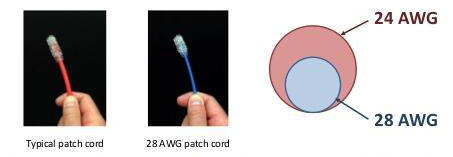28 AWG Copper Cable Solution
When designing the wired network, you may hesitate in making a decision about which kind of network patch cable should be chosen as there are more and more kinds of network patch cables published and available on the market day by day. In this paper, it will highly recommend you to choose a new kind of network patch cable, the 28 AWG (American wire gauge) copper cable, to deploy your wired network, which has the ability to reduce the cabling congestion. To get a deep understanding of this kind of network patch cable, the following will mainly introduce its basic information and analyze why it is so popular among users, which may help you make a better informed decision and avoid the costly network mistakes.
28 AWG copper cable is composed of eight 28 AWG copper conductors that has a much thinner diameter than that of the typical patch cable made up of 23 or 24 AWG copper conductors, aiming at reducing or easing the cabling congestion. For this purpose, it brings great benefits in cable manageability and aesthetics that quickly becomes a viable solution for users to deal with the cabling congestion issues in patch cable areas. To better acquire the structure of the 28 AWG copper cable, here offers a figure that shows the structural differences between the 28 AWG copper cable and the typical patch cable in external and internal aspects.

What should be paid attention to is that the 28 AWG cabling is still not in the TIA/IEEE standards for data communications, although it becomes more and more commonly used nowadays. However, since the 28 AWG copper cable offers several advantages as a desirable cable infrastructure solution, there is no doubt that it will be adopted into the standards sooner or later.
With the fast development of the network, the high density cabling plays a much more important role in data centers than ever before to face the constantly growing requirement. Under this condition, the 28 AWG copper cable becomes more and more popularly used as an ideal cabling solution that makes a great contribution to ease the cabling congestion.
In fact, there are two main reasons that makes the 28 AWG copper cable so popular among users. The one reason is its smaller size. Compared to the typical patch cable, the 28 AWG copper cable has a much smaller diameter, thereby it can offer 50% less cordage. Moreover, the advantage of smaller size enables better air flow, less clutter in front of switches and patch panels. Another reason is that the 28 AWG copper cable has a higher flexibility that makes the cable management easier due to its reduced diameter.
While there are many benefits by using the 28 AWG copper cable, they are also some factors that you should consider if you choose this kind of network patch cable to deploy your network.
The first factor is the transmission distance. As we know, the more the heat is transmitted through the patch cables, the shorter the transmission distance will be. Since there is a reduced diameter in the 28 AWG copper cable, it would be more susceptible to intrinsic loss caused by the heat and adversely affect the transmission distance.
The second factor is the heat and resistance. Generally, the copper cable with smaller diameter has more resistance which would result in the increased heat. That’s to say, when the electricity passes through the resistance, the energy will be dissipated in the form of the increased heat that has an adverse effect on data transmission. You must ensure that there is not too much heat in the 28 AWG copper cable, or the data transmission will be failed.
The third factor is the connector that the 28 AWG copper cable requires. It should be specially designed to match with the 28 AWG copper cable that has smaller diameter. This ensures a proper crimp and strain relief so the assembly would work while in use.
From this paper, it can be concluded that the 28 AWG copper cable requires less cordage, allows for better air flow, less clutter in front of switches and patch panels, and better cable management. The 28 AWG copper cable is really an ideal solution to ease the cabling congestion issue, which is high recommended to deploy the high density network. In addition, before putting this kind of network patch cable into use, you’d better to take the three factors mentioned above into consideration.